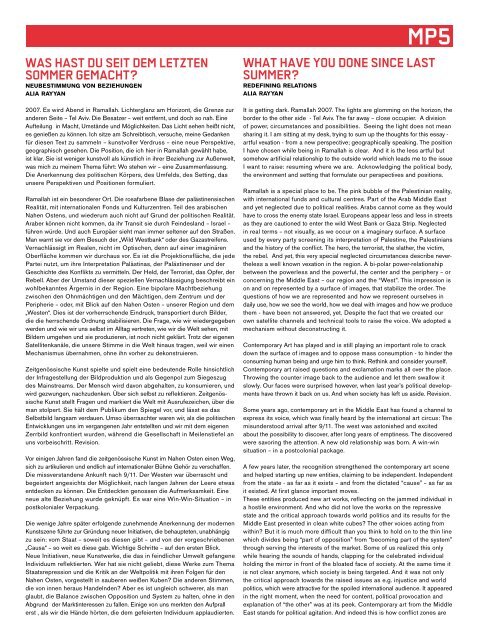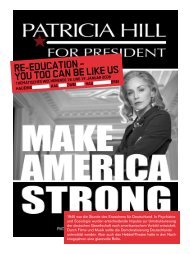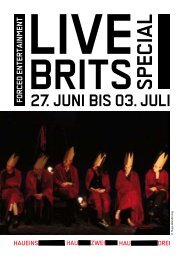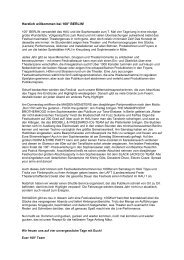mEEting Points - hebbel am ufer
mEEting Points - hebbel am ufer
mEEting Points - hebbel am ufer
Sie wollen auch ein ePaper? Erhöhen Sie die Reichweite Ihrer Titel.
YUMPU macht aus Druck-PDFs automatisch weboptimierte ePaper, die Google liebt.
Was hast du seit dem letzten<br />
Sommer gemacht?<br />
Neubestimmung von Beziehungen<br />
Alia Rayyan<br />
2007. Es wird Abend in R<strong>am</strong>allah. Lichterglanz <strong>am</strong> Horizont, die Grenze zur<br />
anderen Seite – Tel Aviv. Die Besatzer – weit entfernt, und doch so nah. Eine<br />
Aufteilung in Macht, Umstände und Möglichkeiten. Das Licht sehen heißt nicht,<br />
es genießen zu können. Ich sitze <strong>am</strong> Schreibtisch, versuche, meine Gedanken<br />
für diesen Text zu s<strong>am</strong>meln – kunstvoller Verdruss – eine neue Perspektive,<br />
geographisch gesehen. Die Position, die ich hier in R<strong>am</strong>allah gewählt habe,<br />
ist klar. Sie ist weniger kunstvoll als künstlich in ihrer Beziehung zur Außenwelt,<br />
was mich zu meinem Thema führt: Wo stehen wir – eine Zus<strong>am</strong>menfassung.<br />
Die Anerkennung des politischen Körpers, des Umfelds, des Setting, das<br />
unsere Perspektiven und Positionen formuliert.<br />
R<strong>am</strong>allah ist ein besonderer Ort. Die rosafarbene Blase der palästinensischen<br />
Realität, mit internationalen Fonds und Kulturzentren. Teil des arabischen<br />
Nahen Ostens, und wiederum auch nicht auf Grund der politischen Realität.<br />
Araber können nicht kommen, da ihr Transit sie durch Feindesland – Israel –<br />
führen würde. Und auch Europäer sieht man immer seltener auf den Straßen.<br />
Man warnt sie vor dem Besuch der „Wild Westbank“ oder des Gazastreifens.<br />
Vernachlässigt im Realen, nicht im Optischen, denn auf einer imaginären<br />
Oberfläche kommen wir durchaus vor. Es ist die Projektionsfläche, die jede<br />
Partei nutzt, um ihre Interpretation Palästinas, der Palästinenser und der<br />
Geschichte des Konflikts zu vermitteln. Der Held, der Terrorist, das Opfer, der<br />
Rebell. Aber der Umstand dieser speziellen Vernachlässigung beschreibt ein<br />
wohlbekanntes Ärgernis in der Region. Eine bipolare Machtbeziehung<br />
zwischen den Ohnmächtigen und den Mächtigen, dem Zentrum und der<br />
Peripherie – oder, mit Blick auf den Nahen Osten – unserer Region und dem<br />
„Westen“. Dies ist der vorherrschende Eindruck, transportiert durch Bilder,<br />
die die herrschende Ordnung stabilisieren. Die Frage, wie wir wiedergegeben<br />
werden und wie wir uns selbst im Alltag vertreten, wie wir die Welt sehen, mit<br />
Bildern umgehen und sie produzieren, ist noch nicht geklärt. Trotz der eigenen<br />
Satellitenkanäle, die unsere Stimme in die Welt hinaus tragen, weil wir einen<br />
Mechanismus übernahmen, ohne ihn vorher zu dekonstruieren.<br />
Zeitgenössische Kunst spielte und spielt eine bedeutende Rolle hinsichtlich<br />
der Infragestellung der Bildproduktion und als Gegenpol zum Siegeszug<br />
des Mainstre<strong>am</strong>s. Der Mensch wird davon abgehalten, zu konsumieren, und<br />
wird gezwungen, nachzudenken. Über sich selbst zu reflektieren. Zeitgenössische<br />
Kunst stellt Fragen und markiert die Welt mit Ausrufezeichen, über die<br />
man stolpert. Sie hält dem Publikum den Spiegel vor, und lässt es das<br />
Selbstbild langs<strong>am</strong> verdauen. Umso überraschter waren wir, als die politischen<br />
Entwicklungen uns im vergangenen Jahr entstellten und wir mit dem eigenen<br />
Zerrbild konfrontiert wurden, während die Gesellschaft in Meilenstiefel an<br />
uns vorbeischritt. Revision.<br />
Vor einigen Jahren fand die zeitgenössische Kunst im Nahen Osten einen Weg,<br />
sich zu artikulieren und endlich auf internationaler Bühne Gehör zu verschaffen.<br />
Die missverstandene Ankunft nach 9/11. Der Westen war überrascht und<br />
begeistert angesichts der Möglichkeit, nach langen Jahren der Leere etwas<br />
entdecken zu können. Die Entdeckten genossen die Aufmerks<strong>am</strong>keit. Eine<br />
neue alte Beziehung wurde geknüpft. Es war eine Win-Win-Situation – in<br />
postkolonialer Verpackung.<br />
Die wenige Jahre später erfolgende zunehmende Anerkennung der modernen<br />
Kunstszene führte zur Gründung neuer Initiativen, die behaupteten, unabhängig<br />
zu sein: vom Staat – soweit es diesen gibt – und von der vorgeschriebenen<br />
„Causa“ – so weit es diese gab. Wichtige Schritte – auf den ersten Blick.<br />
Neue Initiativen, neue Kunstwerke, die das in feindlicher Umwelt gefangene<br />
Individuum reflektierten. Wer hat sie nicht geliebt, diese Werke zum Thema<br />
Staatsrepression und die Kritik an der Weltpolitik mit ihren Folgen für den<br />
Nahen Osten, vorgestellt in sauberen weißen Kuben? Die anderen Stimmen,<br />
die von innen heraus Handelnden? Aber es ist ungleich schwerer, als man<br />
glaubt, die Balance zwischen Opposition und System zu halten, ohne in den<br />
Abgrund der Marktinteressen zu fallen. Einige von uns merkten den Aufprall<br />
erst , als wir die Hände hörten, die dem gefeierten Individuum applaudierten.<br />
MP5<br />
What have you done since last<br />
summer?<br />
Redefining Relations<br />
Alia Rayyan<br />
It is getting dark. R<strong>am</strong>allah 2007. The lights are glomming on the horizon, the<br />
border to the other side - Tel Aviv. The far away – close occupier. A division<br />
of power, circumstances and possibilities. Seeing the light does not mean<br />
sharing it. I <strong>am</strong> sitting at my desk, trying to sum up the thoughts for this essay -<br />
artful vexation - from a new perspective; geographically speaking. The position<br />
I have chosen while being in R<strong>am</strong>allah is clear. And it is the less artful but<br />
somehow artificial relationship to the outside world which leads me to the issue<br />
I want to raise: resuming where we are. Acknowledging the political body,<br />
the environment and setting that formulate our perspectives and positions.<br />
R<strong>am</strong>allah is a special place to be. The pink bubble of the Palestinian reality,<br />
with international funds and cultural centres. Part of the Arab Middle East<br />
and yet neglected due to political realities. Arabs cannot come as they would<br />
have to cross the enemy state Israel. Europeans appear less and less in streets<br />
as they are cautioned to enter the wild West Bank or Gaza Strip. Neglected<br />
in real terms – not visually, as we occur on a imaginary surface. A surface<br />
used by every party screening its interpretation of Palestine, the Palestinians<br />
and the history of the conflict. The hero, the terrorist, the slather, the victim,<br />
the rebel. And yet, this very special neglected circumstances describe nevertheless<br />
a well known vexation in the region. A bi-polar power-relationship<br />
between the powerless and the powerful, the center and the periphery – or<br />
concerning the Middle East – our region and the “West”. This impression is<br />
on and on represented by a surface of images, that stabilize the order. The<br />
questions of how we are represented and how we represent ourselves in<br />
daily use, how we see the world, how we deal with images and how we produce<br />
them - have been not answered, yet. Despite the fact that we created our<br />
own satellite channels and technical tools to raise the voice. We adopted a<br />
mechanism without deconstructing it.<br />
Contemporary Art has played and is still playing an important role to crack<br />
down the surface of images and to oppose mass consumption - to hinder the<br />
consuming human being and urge him to think. Rethink and consider yourself.<br />
Contemporary art raised questions and excl<strong>am</strong>ation marks all over the place.<br />
Throwing the counter image back to the audience and let them swallow it<br />
slowly. Our faces were surprised however, when last year’s political developments<br />
have thrown it back on us. And when society has left us aside. Revision.<br />
Some years ago, contemporary art in the Middle East has found a channel to<br />
express its voice, which was finally heard by the international art circus: The<br />
misunderstood arrival after 9/11. The west was astonished and excited<br />
about the possibility to discover, after long years of emptiness. The discovered<br />
were savoring the attention. A new old relationship was born. A win-win<br />
situation – in a postcolonial package.<br />
A few years later, the recognition strengthened the contemporary art scene<br />
and helped starting up new entities, claiming to be independent. Independent<br />
from the state - as far as it exists – and from the dictated “cause” – as far as<br />
it existed. At first glance important moves.<br />
These entities produced new art works, reflecting on the j<strong>am</strong>med individual in<br />
a hostile environment. And who did not love the works on the repressive<br />
state and the critical approach towards world politics and its results for the<br />
Middle East presented in clean white cubes? The other voices acting from<br />
within? But it is much more difficult than you think to hold on to the thin line<br />
which divides being “part of opposition” from “becoming part of the system”<br />
through serving the interests of the market. Some of us realized this only<br />
while hearing the sounds of hands, clapping for the celebrated individual<br />
holding the mirror in front of the bloated face of society. At the s<strong>am</strong>e time it<br />
is not clear anymore, which society is being targeted. And it was not only<br />
the critical approach towards the raised issues as e.g. injustice and world<br />
politics, which were attractive for the spoiled international audience. It appeared<br />
in the right moment, when the need for content, political provocation and<br />
explanation of “the other” was at its peek. Contemporary art from the Middle<br />
East stands for political agitation. And indeed this is how conflict zones are









